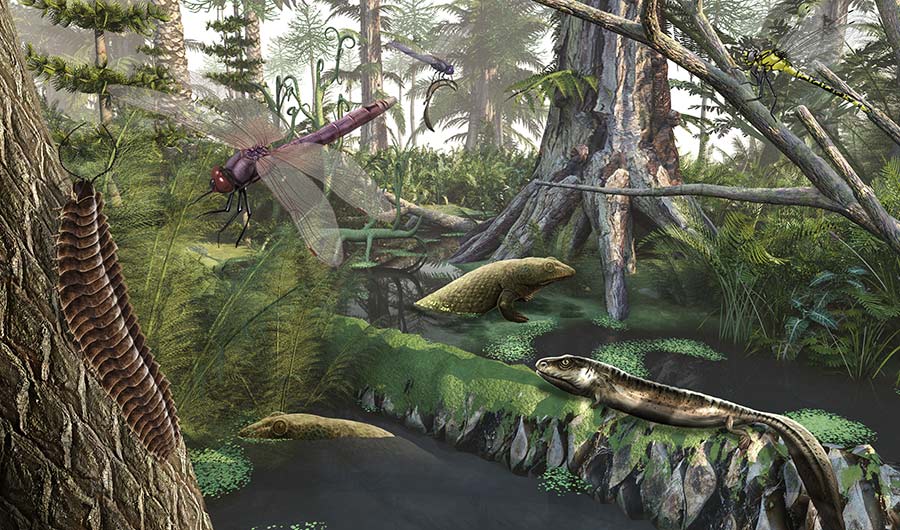The Dawn of the Forests Brought Waves of Death to the Oceans

Nicolas Primola via Shutterstock
( Inside Science ) -- Lub-dub. Lub-dub. Lub-dub.
Like the pulse of a throbbing heart, death beat down upon the seas around 376 million to 360 million years ago. During this time over 70% of animal species disappeared, most of which lived in the ocean. These creatures perished in waves of extinction as oxygen levels in the water oscillated and the downward swings repeatedly suffocated the seas. It was the most devastating period of the Late Devonian Mass Extinction -- one of the five largest extinctions to ever plague the planet. But what triggered these pulses of death has remained a hotly debated topic. Now, scientists believe that the earth's orbital cycles and the emergence of the first forests may have converged to produce this fatal rhythm.
"Oxygen was driven out of the water, and the things living in that water died. Everyone agrees on that," said David De Vleeschouwer, a paleoceanographer from the University of Bremen in Germany. "But why did the ocean suffocate? Why did the oxygen disappear from the water?"
A team of scientists led by Man Lu, a geochemist from the University of Alabama, has found evidence that large amounts of terrestrial nutrients were flushed into the seas in pulses that match the rhythm of the earth's orbital cycles. The researchers believe these nutrients would have fueled the explosion of plankton blooms in the oceans. When the plankton died and decayed, the process would have drained oxygen from the seawater, thereby suffocating other marine life.
The findings, published in the May issue of Earth and Planetary Science Letters, suggest that the nutrients came from Earth's first large forests, implicating burgeoning plant life as an accomplice in one of the greatest death events in history.
The researchers used state-of-the-art techniques to support long-standing hypotheses, said De Vleeschouwer, who was not involved in the research but reviewed the study during the peer-editing process.
In an attempt to unravel what triggered the extinction, Lu and her team took a close look at rocks from a geologic formation called the Chattanooga Shale. They focused on a section called the Upper Kellwasser, which assembled during the deadliest part of the Late Devonian Mass Extinction. These rocks formed from sediments that accumulated on a continental shelf and recorded information about the marine environment during the time.
"I was very lucky to find this outcrop," said Lu, who spent half a year scouring Alabama and Tennessee for study sites. Wielding a 60-year-old geology guidebook, Lu scouted around 20 different study sites. She eventually settled on a roadcut in central Tennessee that was relatively free of vegetation. This was important because plant roots would have made it impossible to detect traces of ancient organic matter, which was exactly what Lu wanted to do.
Back in the lab, Lu and her team analyzed the rocks and measured the concentrations of molecules known to be associated with oxygen levels in the seas, plankton blooms, plant material, and soil and sediment erosion. These chemical fingerprints, or "proxies," provided Lu's team with information about what was going on in the sea during the Late Devonian Mass Extinction.
The researchers analyzed how these proxies fluctuated through the rock record, and they found a cyclic pattern. Like two songs playing at the same time, two simultaneous rhythms appeared in the rocks, beating at intervals of 17,000 and 21,000 years. When the beat from either rhythm struck, signs of nutrient flow and planktonic activity picked up. According to the researchers, these intervals matched the timing of the climatic cycles driven by the wobble of the earth's tilt, or its precession.
Earth's precession influences its seasons, said Sarah Carmichael, a geochemist from Appalachian State University who was not involved in the study. Rainfall and runoff wax and wane with the precession cycles, so nutrient flow will follow the tempo of these cycles.
And in the Late Devonian the continents held an abundance of nutrients. This was a time when plants were invading land and deep soils were starting to form, Carmichael explained. When these new, nutrient-rich soils washed into the sea, they would have spawned massive plankton blooms, which sapped oxygen from the water and choked marine life. And according to Lu's findings, these deathly blooms would have flourished during high rainfall periods influenced by the precession cycles.
"It's an elegant process," said Carmichael. "And they have the data to back it up, and it's all very fine resolution."
However, Carmichael and De Vleeschouwer both believe that some other process, working alongside orbital cycles and forest emergence, likely contributed to the mass extinction. They point to volcanic activity, which was widespread during the Late Devonian. Volcanism may have amplified the extinction pulses by altering the chemistry of the sediments flowing into the seas. "It was probably this perfect cocktail where all these things aligned," De Vleeschouwer said.
Nevertheless, he said, this research shows that this mass extinction in the sea was probably driven by events unfolding on land, not unlike what is occurring today.
We humans are dramatically altering the landscape through our infrastructure and agriculture, and we're putting larger amounts of material from land into the sea, said De Vleeschouwer. "And it's happening at a pace that's much faster than what was happening during the Late Devonian."
This article was updated at 3:51 pm on 4/5/2021 to clarify how plankton blooms affect marine oxygen levels.

